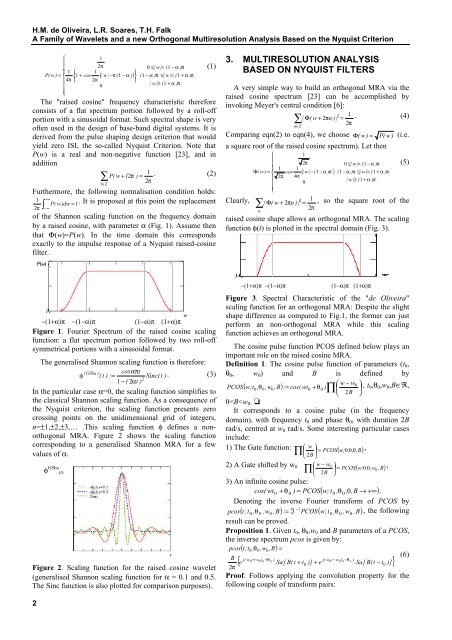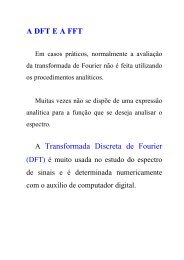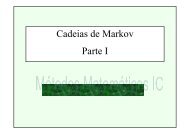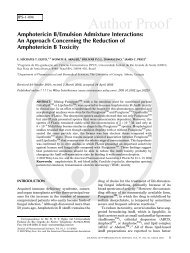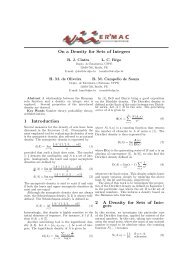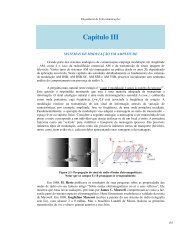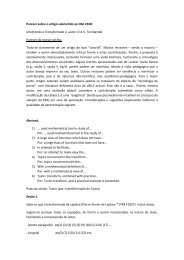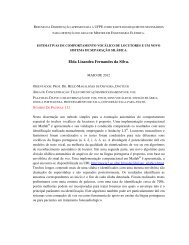A Family of Wavelets and ...
A Family of Wavelets and ...
A Family of Wavelets and ...
Create successful ePaper yourself
Turn your PDF publications into a flip-book with our unique Google optimized e-Paper software.
H.M. de Oliveira, L.R. Soares, T.H. Falk<br />
A <strong>Family</strong> <strong>of</strong> <strong>Wavelets</strong> <strong>and</strong> a new Orthogonal Multiresolution Analysis Based on the Nyquist Criterion<br />
P( w )<br />
⎧<br />
1<br />
⎪<br />
⎪<br />
2π<br />
1 ⎧ 1<br />
= ⎨ ⎨1<br />
+ cos<br />
⎪4π<br />
⎩ 2α<br />
⎪<br />
0<br />
⎪<br />
⎩<br />
( | w | −π<br />
( 1 − α ))<br />
0 ≤|<br />
w | < ( 1 − α ) π<br />
⎫<br />
⎬ ( 1 − α ) π ≤|<br />
w | < ( 1 + α ) π<br />
⎭<br />
| w | ≥ ( 1 + α ) π .<br />
The "raised cosine" frequency characteristic therefore<br />
consists <strong>of</strong> a flat spectrum portion followed by a roll-<strong>of</strong>f<br />
portion with a sinusoidal format. Such spectral shape is very<br />
<strong>of</strong>ten used in the design <strong>of</strong> base-b<strong>and</strong> digital systems. It is<br />
derived from the pulse shaping design criterion that would<br />
yield zero ISI, the so-called Nyquist Criterion. Note that<br />
P(w) is a real <strong>and</strong> non-negative function [23], <strong>and</strong> in<br />
addition<br />
∑<br />
l∈Z<br />
(1)<br />
1<br />
P( w + l2 π ) = . (2)<br />
2π<br />
Furthermore, the following normalisation condition holds:<br />
1<br />
. It is proposed at this point the replacement<br />
2π<br />
∫ +∞ −∞<br />
P( w )dw =1<br />
<strong>of</strong> the Shannon scaling function on the frequency domain<br />
by a raised cosine, with parameter α (Fig. 1). Assume then<br />
that Φ(w)=P(w). In the time domain this corresponds<br />
exactly to the impulse response <strong>of</strong> a Nyquist raised-cosine<br />
filter.<br />
3. MULTIRESOLUTION ANALYSIS<br />
BASED ON NYQUIST FILTERS<br />
A very simple way to build an orthogonal MRA via the<br />
raised cosine spectrum [23] can be accomplished by<br />
invoking Meyer's central condition [6]:<br />
2 1<br />
∑|<br />
Φ(<br />
w + 2πn ) | = . (4)<br />
2π<br />
n∈Z<br />
Comparing eqn(2) to eqn(4), we choose Φ ( w ) = P( w ) (i.e.<br />
a square root <strong>of</strong> the raised cosine spectrum). Let then<br />
⎧<br />
⎪<br />
⎪<br />
Φ(<br />
w ) = ⎨<br />
⎪<br />
⎪<br />
⎪<br />
⎩<br />
1<br />
2π<br />
1 1<br />
cos<br />
2π<br />
4α<br />
0<br />
( | w| −(<br />
1 − α ) π )<br />
0 ≤|<br />
w| < ( 1 − α ) π<br />
( 1 − α ) π ≤|<br />
w| < ( 1 + α ) π<br />
| w| ≥ ( 1 + α ) π .<br />
Clearly, 2 1<br />
∑ | Φ(<br />
w + 2πn ) | = , so the square root <strong>of</strong> the<br />
2π<br />
n<br />
raised cosine shape allows an orthogonal MRA. The scaling<br />
function φ(t) is plotted in the spectral domain (Fig. 3).<br />
(5)<br />
−(1+α)π −(1−α)π (1−α)π (1+α)π<br />
Figure 1. Fourier Spectrum <strong>of</strong> the raised cosine scaling<br />
function: a flat spectrum portion followed by two roll-<strong>of</strong>f<br />
symmetrical portions with a sinusoidal format.<br />
The generalised Shannon scaling function is therefore:<br />
( GSha ) cosαπt<br />
φ ( t ) : = Sinc( t ). (3)<br />
2<br />
1−<br />
( 2αt<br />
)<br />
In the particular case α=0, the scaling function simplifies to<br />
the classical Shannon scaling function. As a consequence <strong>of</strong><br />
the Nyquist criterion, the scaling function presents zero<br />
crossing points on the unidimensional grid <strong>of</strong> integers,<br />
n=±1,±2,±3,… .This scaling function φ defines a nonorthogonal<br />
MRA. Figure 2 shows the scaling function<br />
corresponding to a generalised Shannon MRA for a few<br />
values <strong>of</strong> α.<br />
φ GSha (t)<br />
Figure 2. Scaling function for the raised cosine wavelet<br />
(generalised Shannon scaling function for α = 0.1 <strong>and</strong> 0.5.<br />
The Sinc function is also plotted for comparison purposes).<br />
−(1+α)π −(1−α)π<br />
(1−α)π (1+α)π<br />
Figure 3. Spectral Characteristic <strong>of</strong> the "de Oliveira"<br />
scaling function for an orthogonal MRA: Despite the slight<br />
shape difference as compared to Fig.1, the former can just<br />
perform an non-orthogonal MRA while this scaling<br />
function achieves an orthogonal MRA.<br />
The cosine pulse function PCOS defined below plays an<br />
important role on the raised cosine MRA.<br />
Definition 1. The cosine pulse function <strong>of</strong> parameters (t 0 ,<br />
θ 0 , w 0 ) <strong>and</strong> B is defined by<br />
⎛ w − w0<br />
⎞<br />
PCOS( w;t0 , θ 0 ,w0<br />
,B):<br />
= cos( wt0<br />
+ θ0<br />
) ∏⎜<br />
⎟ , t 0 ,θ 0 ,w 0 ,B∈R,<br />
⎝ 2B<br />
⎠<br />
0


